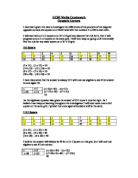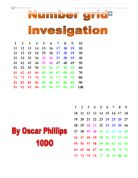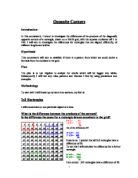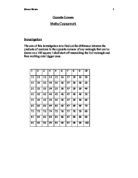This investigation is about finding the difference between the products of the opposite corner numbers in a number square.
Opposite Corners Investigation This investigation is about finding the difference between the products of the opposite corner numbers in a number square. There are three variables which I can change whilst doing my investigation, they are the size of the grid, the shape of the grid and the numbers inside the grid. I am going to start by looking only at number squares with consecutive numbers Consecutive Numbers 2 3 4 5 6 7 8 9 0 1 2 3 4 5 6 4 x 13 = 52 x 16 = 16 Difference = 36 I am now only going to type the corner numbers, as the other numbers are irrelevant 0 3 2 5 0 x 15 = 0 3 x 12 = 36 Difference = 36 -2 0 3 x 10 = 10 -2 x 13 = -26 Difference = 36 The difference seems to be the same, for these 3 the answer is 36 but this isn't proof. Let X stand for the start number which can be any real number. X X + 3 X + 12 X + 15 (X + 3) (X + 12) = X2 + 3X + 12X + 36 = X2 + 15X + 36 X (X + 15) = X2 + 15X Difference = 36 So, the difference between the products of the opposite corner numbers in a 4x4 number square is 36. What about a 3x3 number square? X X + 2 X + 6 X + 8 (X + 2) (X + 6) = X2 + 2X + 6X +12 = X2 + 8X +12 X (X + 8) = X2 + 8X Difference = 12 So, the difference between the products of the opposite corner numbers in a 3x3 number square is 10. What about Other squares? X This investigation does not work with a square
Number Grid Coursework.
Number Grid Coursework 1 2 3 4 5 6 7 8 9 10 11 12 13 14 15 16 17 18 19 20 21 22 23 24 25 26 27 28 29 30 31 32 33 34 35 36 37 38 39 40 41 42 43 44 45 46 47 48 49 50 51 52 53 54 55 56 57 58 59 60 61 62 63 64 65 66 67 68 69 70 71 72 73 74 75 76 77 78 79 80 81 82 83 84 85 86 87 88 89 90 91 92 93 94 95 96 97 98 99 00 Use the following rule: Find the product of the top left number and the bottom right number in the square. Do the same thing with the bottom left and the top right numbers in the square. Calculate the following difference between these numbers. INVESTIGATE! The first thing I'm going to do is work out the rule for a 10 x 10 grid. To do this I'm going to work out what the difference is between each row using 2 x 2, 3 x 3, 4 x 4, and 5 x 5 grids inside the main 10 x 10 one. 0 x 10 grid 1 2 3 4 5 6 7 8 9 10 11 12 13 14 15 16 17 18 19 20 21 22 23 24 25 26 27 28 29 30 31 32 33 34 35 36 37 38 39 40 41 42 43 44 45 46 47 48 49 50 51 52 53 54 55 56 57 58 59 60 61 62 63 64 65 66 67 68 69 70 71 72 73 74 75 76 77 78 79 80 81 82 83 84 85 86 87 88 89 90 91 92 93 94 95 96 97 98 99 00 2 x 2 3 x 3 23 x 14 =
Number Stairs
I have been given a number grid that counts in ascending order from one to a hundred, beginning at the bottom left hand corner to end at the top right corner with the number one hundred. With this grid I have been given the task of investigating the relationship/s between the grid size, the stair size, the stair total and the 'n' number. 91 92 93 94 95 96 97 98 99 00 81 82 83 84 85 86 87 88 89 90 71 72 73 74 75 76 77 78 79 80 61 62 63 64 65 66 67 68 69 70 51 52 53 54 55 56 57 58 59 60 41 42 43 44 45 46 47 48 49 50 31 32 33 34 35 36 37 38 39 40 21 22 23 24 25 26 27 28 29 30 1 2 3 4 35 6 7 8 9 20 2 3 4 5 6 7 8 9 0 The step shape given above is a 3-step stair, simply because it consists of 3 steps. The stair total is labelled as being the sum of all of the numbers in the stair shape: 24 + 25 + 26 + 34 + 35 + 44 = 212 The Stair total for this 3-step shape is 212 The 'n' number is defined as being the smallest number of the stair shape, in the grid above it is specified as ' 24'. I will systematically work my way through this problem to find appropriate algebraic solutions to simplify the workings of the stair totals. In doing so, I will use different size grids and use different size stairs. Again, investigating relationships and discovering formulae for each problem I
Maths Coursework: Number Stairs
Task Statement: I have been set the task of working out the relationship between a 3 - step stair total and the position of the stair shape on the prearranged grid and other stair totals. Aim: As I work through this task I hope to find a formula that will help me to work out any stair total on a 10 by 10 grid. Method: I began by calculating the stair in a vertical sequence ranging from 1 step stair to 8 step stairs. The results of these calculations highlighted a definite pattern. These results were then summarised in a table from which a general formula was found. Key: = Base Number n = Base number Step Stair: Difference = +1 +1 +1 +1 +1 +1 As we can see, the stair total for a 1-step stair using 1 as the base number on a 10 by 10-number grid is 1 as the total = 1. I can therefore conclude that the general equation for a 1-step stair on a 10 by 10 number grid is 1n + 0 = stair total where n is the base number. (Shaded box). Total of step containing 1 as its base number - Difference = 1- 1 = 0 (B) Base number Total number inside 2 2 3 3 4 4 5 5 6 6 7 7 8 8 Formulae: 1n + 0 = Total Testing the formula: Total = 1n + 0 Total = 1 * 2 + 0 Total = 2 + 0 Total = 2 2 Step Stairs: Difference = +3 +3 +3 +3 +3 +3 (B) Base number Total
In this investigation, I will attempt to find out some of the properties of a 2x2 square drawn within a 10x10 number grid. After this I hope to be able to investigate 9x9 and 8x8 grids, next I hope to move on to investigating rectangles.
MATHS Number Grid Coursework Introduction In this investigation, I will attempt to find out some of the properties of a 2x2 square drawn within a 10x10 number grid. After this I hope to be able to investigate 9x9 and 8x8 grids, next I hope to move on to investigating rectangles. 2 3 4 5 6 7 8 9 0 1 2 3 4 5 6 7 8 9 20 21 22 23 24 25 26 27 28 29 30 31 32 33 34 35 36 37 38 39 40 41 42 43 44 45 46 47 48 49 50 51 52 53 54 55 56 57 58 59 60 61 62 63 64 65 66 67 68 69 70 71 72 73 74 75 76 77 78 79 80 81 82 83 84 85 86 87 88 89 90 91 92 93 94 95 96 96 97 98 00 such as 35 36 45 46 when I find the product of the 2 sets of opposite corners I also find that the difference between these answers is ten: 2x2 squares square products difference 35 36 45 46 45 x 36 = 1620 35 x 46 = 1610 0 57 58 67 68 57 x 68 = 3876 67 x 58 = 3886 0 85 86 95 96 85 x 96 = 8160 95 x 86 = 8170 0 My findings are laid out here algebraically (s= starting number) 35 36 45 46 The +10 in the lower left corner is there because every row has ten numbers and so if you look down the columns you will see that here 35+10=40 and 36+10=46 and the +1 is there obviously because every number you count to the right is bigger by 1 i.e. 35+1=36 I shall use
GCSE Maths coursework - Cross Numbers
GCSE Maths coursework Cross Numbers Here is a number square. It shows all the numbers from 1 to 100. I can form cross numbers by placing a cross on this grid. I will use the cross shown below. 2 3 4 5 6 7 8 9 0 1 2 3 4 5 6 7 8 9 20 21 22 23 24 25 26 27 28 29 30 31 32 33 34 35 36 37 38 39 40 41 42 43 44 45 46 47 48 49 50 51 52 53 54 55 56 57 58 59 60 61 62 63 64 65 66 67 68 69 70 71 72 73 74 75 76 77 78 79 80 81 82 83 84 85 86 87 88 89 90 91 92 93 94 95 96 97 98 99 00 In this investigation, I will try to find a master formula for various functions that I use with a certain cross shape. To do this, I will follow the procedure given below: . I will then pick a number on the grid, (labelled as X). 2. Use a mathematical formula using the 4 numbers around it. E.g. (24+33)-(22+13). 3. When an answer is found, I will repeat the formula but pick a different value for X. Repeat this 3 times. If the same answer is achieved, then I will assign an algebraic formula for each number around X. 4. Once I have assigned an algebraic formula for each square, I will replace the numbers in the formula with the algebraic form and justify this mathematically. 5. I will also be changing the horizontal grid value (g) to further my investigation. 6. This will
I am going to investigate by taking a square shape of numbers from a grid, and then I multiply the opposite corners to find the difference of these two results. Firstly I am going to start with a 10x10 grid
Gcse Math's - number grid coursework I am going to investigate by taking a square shape of numbers from a grid, and then I multiply the opposite corners to find the difference of these two results. Firstly I am going to start with a 10x10 grid and pick up 4 different squares, I will start with the 2x2 square. Then I move on and use the 3x3, 4x4 and the 5x5 square. number Left corner x right corner Right corner x left corner Products difference 3x24=312 4x23=322 0 2 4x25=350 5x24=360 0 3 25x36=900 26x35=910 0 I have noticed that the products difference of 2x2 squares in a 10x10 grid equal to 10. I predict if I move the 2x2 square to the right or down I will get the same answer. 4 34x45=1530 35x44=1540 0 My prediction is right. I am going to use algebra to test my results. n n+1 n+10 n+11 (n+1)(n+10)=n²+10+11n n(n+11)=n²+11n Products difference is equal to (n²+10+11n) - (n²+11n) =10 In the same grid I will now work out a 3x3 square. number Left corner x right corner Right corner x left corner Products difference 5 5x37=555 7x35=595 40 6 6x24=144 4x26=104 40 7 6x38=608 8x36=648 40 I have noticed that the products difference of 3x3 squares in a 10x10 grid equal to 40. I predict if I move the 3x3 square to the right or up I will get the same answer. 8 26x48=1248 28x46=1288 40 My prediction is right. I am going to
What the 'L' - L shape investigation.
Alexander Ford 11L WHAT THE 'L' Mathematics GCSE Coursework L Shape Investigation The diagram below shows a standard L shape, which is drawn on a 9 by 9 number grid. 2 3 4 5 6 7 8 9 0 1 2 3 4 5 6 7 8 9 20 21 22 23 24 25 26 27 28 29 30 31 32 33 34 35 36 37 38 39 40 41 42 43 44 45 46 47 48 49 50 51 52 53 54 55 56 57 58 59 60 61 62 63 64 65 66 67 68 69 70 71 72 73 74 75 76 77 78 79 80 81 The total of the numbers inside the L-Shape is 1 + 10 + 19 + 20 + 21 = 71. This is called the L-Sum. The number in the bottom left hand corner of the L-Shape is called the L-Number. The L-Number for this L-Shape is 19. This investigation is in three parts. PART 1 Is to investigate the relationship between the L-Sum and the L-Number. PART 2. Using grids of different sizes is to translate the L-Shape to different positions. Investigate the relationship between the L-Sum, the L-Numbers and the grid size. PART 3. Investigate what happens if you use L-Shapes of different sizes. Try other transformations and combinations of transformations. Investigate relationships between the L-Sum, the L-Number, the grid size and the transformations. I will use the following key to illustrate the algebraic terms that I will use during my investigation: KEY L L-Number C Number of cells in L-Shape G Grid Size ? The
Maths Coursework
Introduction: The task we have been set for this piece of coursework is to investigate numbers presented in a number grid. A box is placed around 4 of the number and the question asked was to find the product of the top left number and the bottom right number. This solution was then taken away from the top right number and the bottom left number like this: 2 3 22 23 (13 x 22)-(12 x23) = 10 Aim: My aim in this coursework is to experiment using 3 different variables in boxes. These will be: size, shape and size of grid. I will investigate boxes that are the same size, bigger, smaller, in different proportions and those that are different in shape. What I mean by this is that I will take boxes of the following proportions: 2x2, 3x3, 4x4, 5x5, 2x3, 2x4, 2x5, 3x4, 3x5, 4x5. I will take 4 boxes of each of type of the above that are squares. I will take these results by using the random function on my calculator. The figure given will be any number in the box. Investigation: 2x2 boxes: My first boxes that I will be investigating are the 2x2 boxes of which I am taking 4. Theses are the boxes I have taken: : 35 36 45 46 (36x45)-(35x46) = 10 2: 57 58 67 68 (58x67)-(57x68) = 10 3: 88 89 98 99 (89x98)-(88x99) = 10 4: 42 43 52 53 (43x52)-(42x53) = 10 Lorenzo Brusini Proving algebraically the 2x2 boxes: For my prediction of this the 2x2 boxes, I
Maths Gridwork
Introduction In this investigation, I have been asked to investigate on a number grid that is 10 wide and 10 descending. We have been asked to test the equation (Top left x Bottom right) - (Top right x Bottom left) on grids varying in size, starting at 2x2, then on to 3x3 and so on. I will describe the constraints of the equation and explain the algebraic rule that determines the end outcome of the grid. I will then relate my new formula and describe how it can be related with rectangles. I will then find a formula that will suit a Master grid. A diagram of the number grid is shown below: 2 3 4 5 6 7 8 9 0 1 2 3 4 5 6 7 8 9 20 21 22 23 24 25 26 27 28 29 30 31 32 33 34 35 36 37 38 39 40 41 42 43 44 45 46 47 48 49 50 51 52 53 54 55 56 57 58 59 60 61 62 63 64 65 66 67 68 69 70 71 72 73 74 75 76 77 78 79 80 81 82 83 84 85 86 87 88 89 90 91 92 93 94 95 96 97 98 99 00 2*2 squares Equation: (TL*BR)-(TR*BL) Example 1 22 23 32 33 (22*33)- (23*32) = -10 Example 2 37 38 47 48 (37*48)- (38*47) = -10 Example 3 57 58 67 68 (57*68)- (58*67) = -10 Example 4 2 2 1 (1*12)- (2*11) = -10 I predict that with all 2*2 grid squares the equation will always produce an answer of -10 Example5 56 57 66 67 (56*67)- (57*66) = -10 I will now use algebra to prove my theory.


























